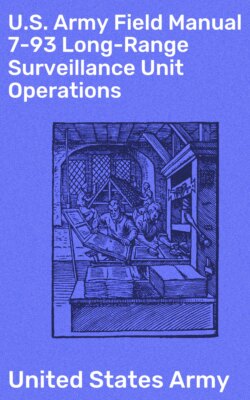Читать книгу U.S. Army Field Manual 7-93 Long-Range Surveillance Unit Operations - United States Army - Страница 3
ОглавлениеSection I - Objective
1–1. Information Gathering
1–2. Human Intelligence Capabilities
1–3. Army Operations Doctrine
Section II - Mission
1–4. Characteristics
1–5. Mission Execution
Section III - Organization
1–6. Long-Range Surveillance Company
1–7. Long-Range Surveillance Detachment
1–8. Capabilities
1–9. Limitations
1–10. Weapons and Equipment
Section I - Command and Control
2.1. Structure
2.2. Mission Taskings
2.3. Types of Missions
2.4. Leadership
2.5. Surveillance Team Operations
2.6. Operations Base
2.7. Tactical Operations Center
2.8 Task Organization
Section II - Communications
2–9. Communication Nets
2–10. Messages and Reports
2–11. Base Radio Station Operations
2–12. Surveillance Team Communications
2–13. Electronic Warfare
Section III - Mission Development
2–14. Planning
2–15. Coordination
2–16. Warning Order
Section IV - Operational Security
2–17. Tactical and Administrative Measures
2–18. Electronic Measures
Section I - Planning Phase
3–1. Contingency Plans
3–2. Control Measures
3–3. Planning Area Activities
Section II - Infiltration Phase
3–4. Movement to the Departure Area
3–5. Stay-Behind
3–6. Infiltration
3–7. Air Insertion
3–8. Amphibious Infiltration
3–9. Land Infiltration
Section III - Execution Phase
3–10. Movement to the Area of Operations
3–11. Hide Site and Surveillance Site Occupation
3–12. Site Selection
3–13. Actions in the Area of Operations
3–14. Reports
3–15. Movement to the Extraction Site
Section IV - Exfiltration Phase
3–16. Distances
3–17. Terrain
3–18. Enemy
3–19. Evasion and Escape
3–20. Extraction by Air
3–21. Land Exfiltration
Section V - Recovery Phase
3–22. Debriefing
3–23. Equipment Maintenance and Turn-In
3–24. Stand-Down
3–25. Training
Section I - Combat Support
4–1. Joint Service Support
4–2. Army Aviation Support
4–3. Fire Support
4–4. Air Defense Artillery Support
4–5. Engineer Support
4–6. Electronic Warfare Support
Section II - Combat Service Support
4–7. Sources
4–8. Supply
4–9. Resupply
4–10. Transportation
4–11. Maintenance
4–12. Medical
4–13. Miscellaneous Services
Chapter 5 - LRS In Operations Other Than War
5–1. Activities
5–2. Planning Factors for Operations Other Than War
5–3. LRS Missions in Operations Other Than War
Section I - Waterborne Operations
6–1. Planning Considerations
6–2. F470 Zodiac Boat
6–3. Scout Swimmer
6–4. Helocasting Operations
Section II - Helicopter Operations
6–5. Rappelling
6–6. Special Patrol Infiltration/Exfiltration System
6–7. Fast-Rope Infiltration/Exfiltration System
6–8. Army Aviation and Air Assault
Section III - Airborne Operations
6–9. Landing Plan
6–10. Air Movement Plan
6–11. Marshalling Plan
Section IV - Stay-Behind Operations
6–12. Planning
6–13. Site Preparation
Section V - Vehicle Operations
6–14. Planning
6–15. LRS Team Planning
Section VI - Foot Movement Operations
6–16. Planning
6–17. Movement
Appendix A - Personnel Recruitment and Selection
Appendix B - Long-Rance Surveillance Reconnaissance
Appendix C - Geographic Environments
Appendix E - LRSU Hide and Surveillance Sites
Appendix F - Tracking and Countertracking, Evasion and Escape, and Survival
Appendix I - Briefback and Debriefing Formats
Appendix J - Movement Techniques and Battle Drills
Footnotes
Authorization Letter
